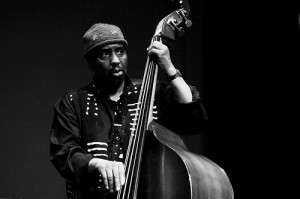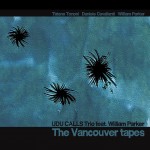Place of Birth: Bronx, NY
Date of Birth: January 10, 1952
Education: Private studies with Richard Davis, Jimmy Garrison, Wilbur Ware and Paul West.
Fellowships, Prizes, Grants, Honors, Residencies
-New York State Music Fund commission of “Double Sunrise Over Neptune,” performed at Vision Festival XII in June 2007-Named as one of the “50 Greatest New York Musicians of All Time” in Time Out New York, March 2007
-Residency at Luther College’s “A Sense of Vocation” program in Decorah, Iowa, 2007
-Nameless Sound Resounding Vision Award, Houston, TX, 2006
-Residency at Hallwalls in Buffalo, NY, 2006
-Jazz Musician of the Year, Musica Jazz (Italian Magazine), 2005
-Participant in Visiting Artist Program at Haystack in Deer Isle, Maine, 2004
-Other Minds Festival commission of “Spirit Catcher for Four Musicians and Tape,” in San Francisco, CA March 2003
-Residency at the Djerassi Foundation in Woodside, CA, 2003
-Mary Flagler Cary Charitable Trust Commission of “Universal Tonality,” in 2002
-New York State Council on the Arts Commissioning Award, 2000
-Residency at Bennington College, Bennington, VT, 1991
-Residency at the Rotterdam Conservatory, 1991 and 1994
-New York Foundation for the Arts (NYFA) Artist Fellowship, 1988
Work, Highlights
2007: Premiered “Double Sunrise Over Neptune,” which was presented at Vision Festival XII and commissioned, recorded and commercially issued by Arts for Art with support from the New York State Music Fund. Recorded Alphaville Suite for double quartet. Premiered multimedia piece, “Expanded Humanity” with students from Humanities Preparatory Academy (NYC) and the Amistad Academy (Hartford, CT).
2006: Premiered “Lakota Chamber Music,” for woodwinds and “Light In The Hall of Whispers,” for string ensemble. Residency at Hallwalls in Buffalo, NY and performed theatre/Dance/Music Piece “Looking For Cookie Gilchrist” in collaboration with Patricia Nicholson.
2005: Played at Tel Aviv Jazz Festival with Roy Campbell’s Pyramid Trio, Voted Jazz musician of the year in Italy by Musica Jazz. Taught at the New School for Jazz and Contemporary Music.
2002: “Universal Tonality” premiered at Roulette, commissioned by the Mary Flagler Cary Charitable Trust.
2001: William Parker Quartet formed, recorded “O’Neal’s Porch.” Taught at the Rotterdam Conservatory. Premiered project entitled The Inside Songs of Curtis Mayfield.
2000: William Parker Quartet formed, recorded “O’Neal’s Porch, recognized in 2001 by the New York Times as one of the Best Jazz Albums of the Year. “Kaleidoscope” premiered at the Fifth Annual Vision Festival, commissioned by Arts for Art with funds provided by NYSCA and performed by the Little Huey Creative Music Orchestra. Premiered “Big Orange Mountain,” performed by the Kitchen House Blend Band.
1999: The Little Huey Creative Music Orchestra performed at Alice Tully Hall.
1998: The Little Huey Creative Music Orchestra and Dance performed “Mass for the Healing of the World” at Verona.
1995: Premiered 10 compositions in an 8-week season with the Little Huey Creative Music Orchestra at the Knitting Factory. Composed music for the dance-drama “The Shadow People.”
1994: Founded the Little Huey Creative Music Orchestra. Composed new music for Czechoslovak-American Marionette Theater, as well as arranging and re-orchestrating music from Dvorak’s opera “Rusalka.”
1993: Founded sextet In Order to Survive, which performed at Roulette and the Knitting Factory.
1991: Participated in Total Music meeting, Berlin, Germany. Composed music for Marcus Dance Theater, “The Generation Table,” performed at PS 122, and for Denis Charles Dance Troupe. Toured Japan, England, France and Germany with Cecil Taylor’s Feel Trio.
1988-89: Co-organized Second Sound Unity Festival, New York City. Presented “Vision on an Ordinary Day,” a composition for large ensemble, with poetry, voice and dance, at Cooper Hewitt Museum.
1986 – 87: Composed and presented “Vision Peace and Battle Cries,” a modern ballet for large orchestra with poetry and voice in collaboration with choreographer Patricia Nicholson at La MaMa. Toured Japan with Billy Bang and Europe with Cecil Taylor.
1985: Composed music for documentary shown on PBS, “Community Dig.”
1984: Co-organized “Sound Unity,” a five day international festival at CUANDO, New York City.
1983: Premiered composition, “Inheritance” for three voices, bassoon, alto flute, double bass and dance in Downtown Music Series at Third Street Music School.
1982: Premiered “A Thousand Cranes,” an opera for orchestra, dance and a chorus of 1000 school children, performed at opening of UN Second Special Session for Disarmament, June 1982.
1981: Concerts for solo bass in Berlin. Composed “Peace Suite” a composition for large ensemble, voices, dance and poetry. Toured Europe with Cecil Taylor Unit.
1980: Composed and performed “Night Skies,” a modern ballet in collaboration with choreographer Patricia Nicholson. Joined Cecil Taylor Unit.
1978: CETA Artist Program with Theatre for Forgotten. Composed for many of theater productions and performed in prisons and hospitals.
1975: Performed at the Five Spot with Don Cherry.
1974: Performed with Cecil Taylor’s big band at Carnegie Hall
William Parker is an improviser, and composer. He plays the bass, shakuhachi, double reeds, tuba, donson ngoni and gembri. He was born in 1952 in the Bronx, New York. He has studied bass with Richard Davis, Art Davis, Milt Hinton, Wilber Ware, and Jimmy Garrison.
William Parker entered the music scene in 1971, playing at Studio We, Studio Rivbea, Hilly’s on The Bowery, the Salt and Pepper club and The Baby Grand, and quickly became a sought after bass player in the New York music scene. He has played with many musicians from the avant-garde such as, Bill Dixon, Sunny Murray, Charles Tyler, Billy Higgins, Charles Brackeen, Alan Silva, Frank Wright, Frank Lowe, Rashid Ali, Donald Ayler, Sonny Simmons, Jeanne Lee, Gunter Hampel, Karl Berger Dave Burrell, Don Cherry, Cecil Taylor, Jimmy Lyons, Milford Graves and with traditionalists like Walter Bishop, Sr. and Maxine Sullivan.
William’s early collaborations with the dancer and choreographer Patricia Nicholson created a large repertoire of composed music for ensembles ranging from solo works to big band projects. Parker played in the Cecil Taylor Unit from 1980 through 1991. He has also performed with musicians from the AACM such as Muhal Richard Abrams, Roscoe Mitchell, Henry Threadgill, Anthony Braxton, Wadada Leo Smith, Ernest Dawkins, and The Art Ensemble of Chicago.
WParLnoonan-1
In addition to his work with artists in the United Stated, William Parker has developed a strong relationship with musicians in the European Improvised Music scene such as Peter Kowald, Peter Brotzmann, Han Bennink, Tony Oxley, Derek Bailey, Franz Hautzinger, Tomasz Stanko, John Tchicai , Louis Sclavis, Conny Bauer, Hannes Bauer, and Louis Moholo.
In 1994 William began leading his own bands, In Order To Survive, and The Little Huey Creative Music Orchestra. 2001 marked a turn toward a more universal sound by working with drummer Hamid Drake on O’Neal’s Porch. The Raining on the Moon Quintet followed, with addition of vocalist Leena Conquest to the O’Neals Porch quartet. Most notable among many recent projects is the Inside Songs of Curtis Mayfield.
William has taught at Bennington College, NYU, The New England Conservatory of Music, Cal Arts, New School and The Rotterdam Conservatory of Music. He has also taught music workshops in cities throughout the world including Paris, Berlin and Tokyo and the Lower East Side of New York.
Parker is also a theorist and author of several books including the Sound Journal (centeringmusic), Document Humanum (centeringmusic) , Music and the Shadow People (centeringmusic) and The Mayor of Punkville (centeringmusic).
Steve Greenlee of the Boston Globe stated in July 2002, “William Parker has emerged as the most important leader of the current avant-garde scene in jazz.” He is working in many of the more important groups in this genre, some of the most prestigious being his own, i.e. The Curtis Mayfield Project, Little Huey Creative Orchestra, In Order to Survive, William Parker’s Quartet and other groups. Mr. Parker is one of the most important composers in our time period, he is also a poet whose words are beginning to be heard in various media: in print, in song and in his theatre piece, “Music and the Shadow People.”s/performances for young people that he has conducted, both in the USA and in Europe. This has been for him amongst some of his most important work and greatest successes.”
In ‘95 the Village Voice characterized William Parker as “the most consistently brilliant free jazz bassist of all time.”
Mr. Parker has released over 20 albums under his leadership. In 1995 after years of obscurity as a leader, he released Flowers Grow In My Room, on the Centering label. This was the first documentation of the Little Huey Creative Music Orchestra. This CD hit #1 on the CMJ charts and The Little Huey began to tour. They have performed in the Verona Jazz Festival and Banlieues Bleues among others. William Parker’s new Quartet has hit with rave reviews for both albums “O’Neals Porch” and “Raining on the Moon.”
These releases and their success highlight William Parker as an outstanding composer and bandleader. From the beginning of his musical career, William Parker has been prolific, composing music all of the music for his projects. His compositional skills span a range including operas, oratorios, ballets, film scores, and soliloquies for solo instruments. He has also successfully explored diverse concepts in instrumentation for large and small ensembles.
William Parker is a poet, with three volumes published thus far: “Music Is,” “Document Humanum,” and “The Shadow People.”
“He (William Parker) is something of a father figure” stated Larry Blumenfeld in a New York Times article. He has looked for and encouraged young talent and has been a mentor to many young musicians.

